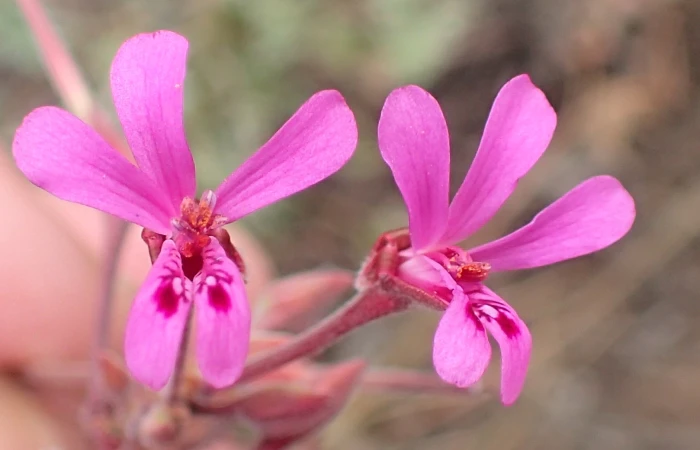Kidney-Leaf Pelargonium
(Pelargonium reniforme)
Kidney-Leaf Pelargonium (Pelargonium reniforme)
/
/

Nicola van Berkel
CC BY-SA 4.0
Image By:
Nicola van Berkel
Recorded By:
Copyright:
CC BY-SA 4.0
Copyright Notice:
Photo by: Nicola van Berkel | License Type: CC BY-SA 4.0 | License URL: http://creativecommons.org/licenses/by-sa/4.0/ | Rights Holder: Nicola van Berkel | Publisher: iNaturalist | Date Created: 2019-01-19T08:48:44-08:00 |










































Estimated Native Range
Climate Requirements for Burleson, Texas
| This Plant | Your Site | Plant Suitability for Your Location | ||
|---|---|---|---|---|
| • Precipitation | 9" - 36" | 34" | Your precipitation may be too high for this plant. | Too high |
| • High Temp. | 71°F - 97°F | 96°F | Your summer temperatures are normal for this plant. | Excellent |
| • Low Temp. | 27°F - 51°F | 33°F | Your winter temperatures are normal for this plant | Excellent |
This plant may not grow well at your location - your precipitation is too high.
Summary
Pelargonium reniforme, commonly known as Kidney-Leaf Pelargonium, is an evergreen shrub native to the Eastern Cape of South Africa, where it thrives in rocky slopes and shrublands. This plant typically grows to a height of 0.8 feet (0.2 meters) and can spread up to 2 feet (0.6 meters) wide. It has a compact growth habit with kidney-shaped leaves that are softly hairy and aromatic when crushed. The Pelargonium reniforme produces clusters of showy, pink flowers with darker markings on the upper petals during its blooming season in spring and summer, which attract pollinators such as bees.
Kidney-Leaf Pelargonium is valued for its drought tolerance and attractive foliage, making it suitable for rock gardens, Mediterranean-style landscapes, and as a container plant. It is also used in traditional medicine for its astringent properties. In cultivation, it requires minimal maintenance, thriving in full sun and well-draining soil with low water needs once established. It is not commonly affected by diseases but can be susceptible to root rot if overwatered. To ensure healthy growth, it is recommended to provide occasional water during prolonged dry periods and to prune lightly after flowering to maintain its shape.CC BY-SA 4.0
Kidney-Leaf Pelargonium is valued for its drought tolerance and attractive foliage, making it suitable for rock gardens, Mediterranean-style landscapes, and as a container plant. It is also used in traditional medicine for its astringent properties. In cultivation, it requires minimal maintenance, thriving in full sun and well-draining soil with low water needs once established. It is not commonly affected by diseases but can be susceptible to root rot if overwatered. To ensure healthy growth, it is recommended to provide occasional water during prolonged dry periods and to prune lightly after flowering to maintain its shape.CC BY-SA 4.0
Plant Description
- Plant Type: Shrub
- Height: 0.8-1 feet
- Width: 1-1.5 feet
- Growth Rate: Moderate
- Flower Color: Pink
- Flowering Season: Spring, Summer
- Leaf Retention: Evergreen
Growth Requirements
- Sun: Full Sun
- Water: Low
- Drainage: Medium, Fast
Common Uses
Bee Garden, Butterfly Garden, Deer Resistant, Drought Tolerant, Groundcover, Low Maintenance, Potted Plant
Natural Habitat
Rocky slopes and shrublands in the Eastern Cape of South Africa
Other Names
Common Names: Yurtle The Purple Geranium, Rooirabas
Scientific Names: Pelargonium reniforme
GBIF Accepted Name: Pelargonium reniforme (Andr.) Curtis